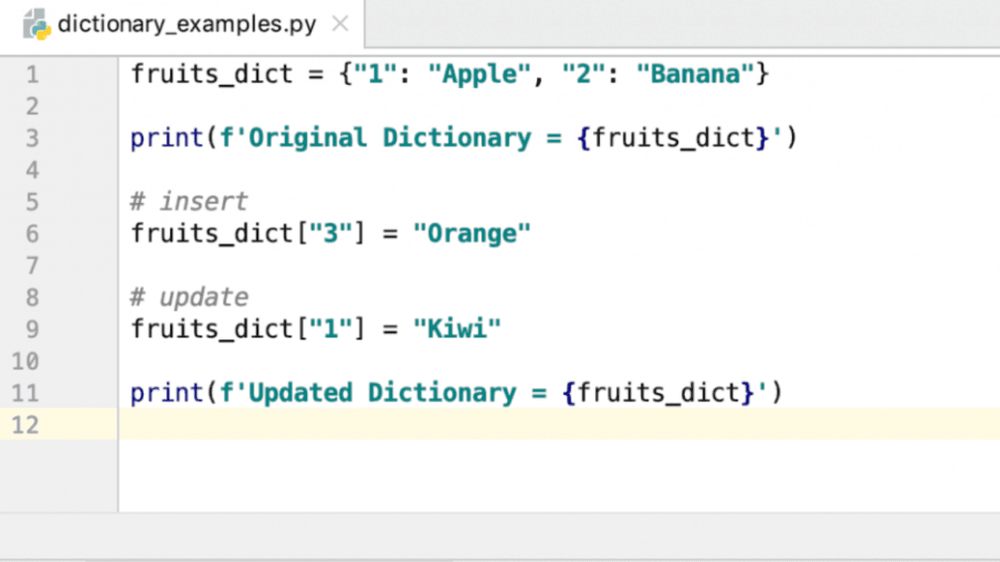Discover how the Python dictionary data structure functions as a strong and flexible way to store and retrieve objects and data in your applications.
Python is a high-level, interpreted, object-oriented programming language that allows us to build a wide range of applications. “Data Dictionaries” are one of the many different forms of data structures.
What is a Data Dictionary?
Dictionaries are powerful data structures in Python that store data as key pairs, this being represented in the following form: Key-Value. Dictionary comprehension (or dict comprehension) can be very useful in creating new dictionaries based on existing and iterable dictionaries.
Python dictionaries are made up of one or more keys and the values that go with them. Any Python object can serve as the value for each key. This kind of data structure is sometimes referred to as an associative array or a hash map in other languages. It employs a key to get the values that are associated with it, and the lookup time is fixed.
We will go through the fundamentals of Python dictionaries in this post, including how to use them, the situations in which they make sense, and some typical issues and traps to watch out for.
The dictionary’s components are all encased in a pair of square brackets.
- A dictionary’s elements each have a key and a value, or a key-value pair.
- An item is a key-value pair.
- The benefit of the approach is that all stored values may be accessed by utilizing just the keys.
Here is a structure appropriate for a dictionary:

In the previous example,
The dictionary my_dictionary contains four key-value pairs, that is, four elements.
“key1” through “key4” are the four keys.
You can use my_dictionary[“key1”] to access , and my_dictionary[“key2”] to access , and so on.
How to Build a Python Dictionary From an Iteration Using Dictionary Compression
In this part, we’ll utilize dictionary compression to turn a list or tuple into a Python dictionary.
If we decide to produce either the keys or the values instantly, we may build a new dictionary in Python using simply an iterable.
The iterable’s items can be used as keys and vice versa depending on how we decide to produce the values in question.
Below is a general illustration of syntax. You should be aware that the names in brackets (>) are placeholders for the variable names.

Let’s examine the syntax shown above.
- The Greek letter denotes the definition of a dictionary.
- We create a key-value pair for each element of the iterable.
Understanding Python Dictionaries: Example
Let’s say we have a list of customers that come into our business, and we want to give each one a random discount. Additionally, we would like the discount amount to range from $1 to $100.
In Python, random.randint(i,j) returns a value between i and j including both extremes.
As a result, we may create a discount between $1 and $100 for each consumer in the list using the randint() method.
The code below will demonstrate how to build a discount dictionary from a list of clients.

The aforementioned example operates as follows:
- Going once through the list of clients.
- Use the name of each client as a key.
- Create a randomized discount on each key, with a range of $1 to $100.
How to Utilize a Python Dictionary’s Items() Function
We have already shown how to access values using keys. But how can we have access to all of a dictionary’s key-value pairs?
We utilize the dictionary’s items() function to retrieve all the key-value pairs to do this.

How to Build a Python Dictionary From an Existing Dictionary Using Dictionary Understanding
Let’s now consider the scenario in which we already own a Python dictionary.
However, we want to make a new dictionary that only has the words from the current one that meets a specific requirement.

Now let’s go through the syntax. We retrieve every key-value pair in the current dictionary using the items() function.
- To determine whether our condition evaluates to True, we access the first item in the dictionary.
- The condition is True if we add the first item to our vocabulary.
- The only thing left to do is to sequentially repeat these processes for each entry of our current dictionary.
Python Dictionaries – Example 2
Recall the bargain dictionary from our earlier illustration.

We can observe that some customers were fortunate enough to receive more discounts than others. Let’s investigate this discrepancy and please every client.
People who have received a discount of less than $30 are eligible for a 10% discount on their subsequent purchase.
We are building a new dictionary clientele 10 in this instance using our discount dictionary.

The code above explains the following:
- The value of the discount is assessed for each item in our discount dictionary.
- If the applicable discount was less than $30, the comparable discount is added together with our new customer 10 dictionary.
The updated lexicon now includes Alex, Bob, and Dave who each received discounts totaling less than $30.
The Synopsis of Python Dictionaries
Let’s review everything we discovered during this session. By building new dictionaries in Python, we learned how to utilize dictionary comprehension. belonging to a single iterable and an existing dictionary that filters over the contents using conditionals. Interested in learning more about Python? Looking for a new challenge as a Python developer? We recommend that you elevate your career with Nucamp's Python and SQL Bootcamp.



